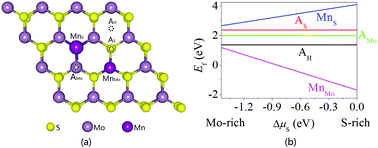Structural stability and magnetic-exchange coupling in Mn-doped monolayer/bilayer MoS2†
Abstract
Ferromagnetic (FM) two-dimensional (2D) transition metal dichalcogenides (TMDs) have potential applications in modern electronics and spintronics and doping of TMDs with transition metals can enhance the magnetic characteristics. In this work, the structural stability, electronic states, and magnetic properties of Mn-doped monolayer/bilayer MoS2 are studied systematically by first-principles calculations. Substitutional Mn dopants at the Mo sites are energetically favorable in both monolayer and bilayer MoS2 under the S-rich condition which is common in the synthesis of MoS2 nanosheets. Two Mn dopants participate in the FM interaction in monolayer MoS2 and magnetic coupling of two Mn dopants via the double-exchange mechanism can be mediated by the nearest neighboring S. Magnetic coupling can be ascribed to the competition between the double-exchange, direct-exchange, and super-exchange interactions, which take place between two Mn dopants in bilayer MoS2 with the MniMnMo, MniMnS and MnMo–MnMo configurations. Our results reveal the geometrical dependence of magnetic-exchange coupling suggesting that Mn-doped monolayer/bilayer MoS2 has large potential in spintronic devices.



 Please wait while we load your content...
Please wait while we load your content...